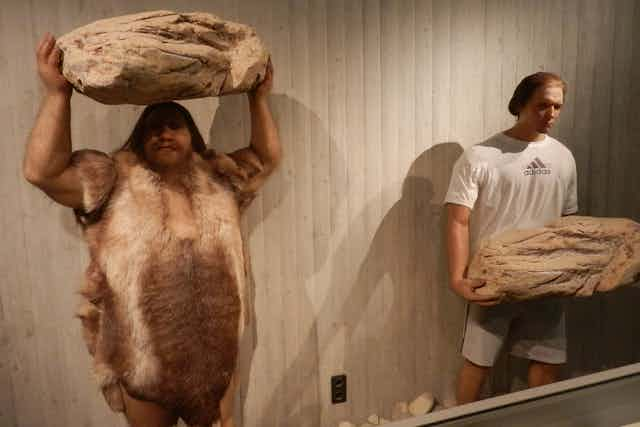Research out today in leading science journals firms up estimates of interbreeding between the now extinct Neanderthals and the ancestors of living Eurasians. They also provide new explanations about the circumstances surrounding the flow of genes into our species when the first modern humans (Homo sapiens) left Africa to settle the rest of the Old World.
The new work was reported in two articles: one in Nature by Sriram Sankararaman and co-workers from Harvard University and the Max Planck Institute for Evolutionary Anthropology, and the other in Science by Benjamin Vernot and Joshua Akey from the University of Washington.
Remarkably, both groups sought independently to characterise the nature of Neanderthal gene flow and its likely consequences for living people. They came to similar conclusions that will undoubtedly cause a major upset among anthropologists.
Genetic patchwork
Sankararaman and colleagues compared the genome of a Neanderthal from southern Siberia with the genomes of more than a thousand contemporary humans using three new methods to search for Neanderthal genes.
They found that, on average, living Europeans have inherited around 1.2% and East Asians about 1.4% of their DNA from our Stone Age cousins. This is somewhat less than has been reported previously.

Yet, the signs of interbreeding are scattered in a patchwork across our genomes: some parts are devoid of Neanderthal genes while others contain as much as 62-64% Neanderthal DNA.
They asked: why would such a mosaic exist? The most reasonable explanation seems to be that natural selection acted against many genes by removing them from the gene pool of humans not long after interbreeding occurred.
How? It’s well known from living organisms that interbreed (hybridise) naturally that this kind of sorting is the normal situation. In many species – plants, invertebrates and vertebrates – interbreeding between species tends to proceed in a mosaic fashion.
Their genomes are not just swapped in their entirety between species, but rather they are “semi-permeable”, with only certain genes getting through or surviving over time and fixing in the other species’ genome.
In other words, natural selection would have largely weeded out the Neanderthal-human crosses because their mixed-up genomes led to a reduction in survival and reproductive success. Hybrids were selected against!
How did this happen? Sankararaman and co-workers looked at the autosomes (non-sex chromosomes) and X chromosomes and found that the latter were essentially free of Neanderthal genes. What’s significant about this is that genes associated with male sterility in living humans and many other animals are found disproportionately on the X chromosome. This strongly implies that natural selection removed them from the human gene pool owing to their negative effects on male reproduction.

So, the hybrid humans or Neanderthals were probably either sterile or very infertile.
Sankararaman and co-workers also found a number of genes that affect human skin and hair, possibly aiding modern humans to survive in the new and harsher environments of Asia and Europe.
They also discovered that genes of likely Neanderthal origin also have negative consequences in living Eurasians, including genes involved in lupus, biliary cirrhosis, Crohn’s disease, optic-disk size, IL-18 levels (associated with inflammatory disease), type 2 diabetes and even smoking behaviour.
A fifth of Neanderthal DNA lives on
The Science study by Vernot and Akey focused on a new approach in which they used a statistical method to search for candidate Neanderthal DNA within living humans, crosschecking their findings against the fossil genome. Their aim was in part to develop a method that could identify genes introduced through interbreeding with other species purely by examining contemporary human DNA.
The pair found that about 20% of the Neanderthal genome is found in living humans – with different segments on different chromosome and across individuals. They also found that the genomes of living East Asians typically contain 21% more Neanderthal DNA than the genomes of Europeans.
Their study also showed, independently, that the genetic differences between Neanderthals and modern humans acted as a barrier to gene flow in some regions of the genome and were harmful for the hybrids.
They identified several genes apparently inherited from Neanderthals that are associated in living Eurasians with the skin and hair, particularly skin pigmentation (colour) and its loss. This suggests that Neanderthals may have provided modern humans, especially in Europe, with genes that affect variation in skin phenotypes with major consequences for survival.

Breeding between species – it happens
The first Neanderthal genome sequence was published in 2010 and research has come a long way in that short time. These most recent studies lead to the strong conclusion that interbreeding between our kind and our Neanderthal cousins was an interspecies affair, confirming what a number of us fossil-jocks have thought for some time.
A surprise? Not really. Many of our living primate cousins interbreed naturally in the wild: estimates show more than 10% of primate species do it!
Doesn’t this run counter to the very definition of a species? Not unless you take an overly simplistic, or iconoclastic, approach to defining them. Even the man credited more than anyone with developing the “biological species concept” based on reproductive isolation – the late Ernst Mayr – recognised that interbreeding sometimes occurs between them.
Also unsurprisingly, a number of my anthropologist colleagues have already co-opted the finding of interbreeding to suit their long-held (pet) theories about the evolution of Homo sapiens.
Given that these theories – from Multiregionalism through to Out-of-Africa Replacement – are conceptually incompatible, and empirically irreconcilable, they can’t all be right.
The latest findings from genome comparisons reinforce the status of Neanderthals and modern humans as distinct species. Those anthropologists who continue to regard Neanderthals as members of Homo sapiens now face a stronger challenge than ever reconciling their position with the DNA.

